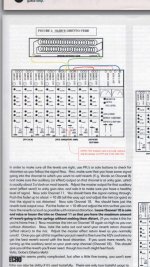Hi. I would like to build a reverb unit to be used for vocals. It would be used in a live setting primarily, but it might find a place in the studio if it outputs a nice or unique sound.
For size considerations, I would like to stay away from spring-based units. I have several years experience with circuit building, so if you know of a design, pass it on.
Any ideas?! Thanks for your help. The audio knowledge on this board is impressive! 🙂
-fender4
For size considerations, I would like to stay away from spring-based units. I have several years experience with circuit building, so if you know of a design, pass it on.
Any ideas?! Thanks for your help. The audio knowledge on this board is impressive! 🙂
-fender4
Here's one for you to read
This DIY Reverb page on Hometracked lead me to this article from ETI magazine using the MN3011 BBD
As it's got plenty of "how it works" info you should be able to clone it with whatever BBD device you can get your hands onto.
Otherwise you're into ADC/CPU/DAC territory.
Welcome back.Hi. I would like to build a reverb unit..., I would like to stay away from spring-based units.
This DIY Reverb page on Hometracked lead me to this article from ETI magazine using the MN3011 BBD
As it's got plenty of "how it works" info you should be able to clone it with whatever BBD device you can get your hands onto.
Otherwise you're into ADC/CPU/DAC territory.
Hi, fender4 hasn't logged on since 2006.
Accutronics (Belton) makes a solid state reverb module for under $15. Needs +5, ground, in and out.
Accutronics (Belton) makes a solid state reverb module for under $15. Needs +5, ground, in and out.
I always wondered if these could be integrated into old tube amps. I assume not because the old transformers wouldn't have those additional +5s right?
Enzo would you have a link to share for that Accutronics module (did not see it on their site)
would a 5 volt supply from the heater section cause any grief?
would a 5 volt supply from the heater section cause any grief?
The Belton / Accutronics modules are available from AES (tubesand more.com). The data sheets are on their site. Select "reverb tanks" from their site menu, then search for "belton."
Here is the docs for the one I used.
Yes, you can use the 6.3 volt winding in a tube amp for power if it is already floating with a FWB. It might be possible to use a single half wave diode if one side of the heater winding is grounded, but I have not tried this.
Here is the docs for the one I used.
Yes, you can use the 6.3 volt winding in a tube amp for power if it is already floating with a FWB. It might be possible to use a single half wave diode if one side of the heater winding is grounded, but I have not tried this.
Attachments
@Tubelab_com,
Is that you in the pic? You must pump alot of soldering iron 😛
@Enzo,
Unless it is fairly brainless, I don't know if I would attempt cobbling a +5 from existing circuit unless the transformer had 5 volt taps.
Is that you in the pic? You must pump alot of soldering iron 😛
@Enzo,
Unless it is fairly brainless, I don't know if I would attempt cobbling a +5 from existing circuit unless the transformer had 5 volt taps.
I don't mean to sound unkind, but I assumed when you asked about building in a reverb circuit, that you had the electronic skills required. Power supplies are fairly straightforward. They can be derived off existing circuits often. If the amp has a bias tap on the PT, we could tap a diode into that for a positive supply as easily as the negative bias supply. it would never know the difference. Granted, that would start out closer to 50v than 5v, but it is simple to adjust that.
@Tubelab_com,
Is that you in the pic?
That is me, but I have shrunken about 15 pounds since that picture was taken.
I don't know if I would attempt cobbling a +5 from existing circuit unless the transformer had 5 volt taps........that would start out closer to 50v than 5v, but it is simple to adjust that
The Belton module draws 60 to 100 mA, so the choices are rectified heater power, a separate supply, or dropping 50 volts down to 5. A buck converter is about the only way to lose 45 volts without making a lot of heat.
If you "compromise" with a spring unit then this maybe of interest!!!
My take on the 6G15 reverb unit - the Lamington Reverb
Cheers,
Ian
My take on the 6G15 reverb unit - the Lamington Reverb
Cheers,
Ian
Read carefully the "60`s reverb" project, it needs only a few mA and they explain how to get them from a tube amp HV supply, also how to interface it with tube preamp circuits.
And yes, it´s based on an Accutronics suggested circuit, so it´s an "official" version.
Way back then I built lots of them for my guitar playing friends.
And yes, it´s based on an Accutronics suggested circuit, so it´s an "official" version.
Way back then I built lots of them for my guitar playing friends.
- Status
- Not open for further replies.
- Home
- Live Sound
- Instruments and Amps
- Easy DIY reverb?

